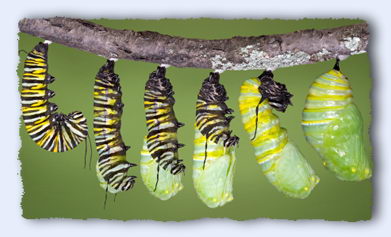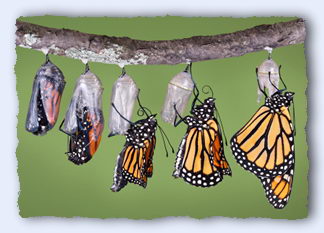|
|
Do you remember?
About genes.
Here's this butterfly, the Monarch Danaus plexippus.
It's in Canada. In August. It jumps up into the sky and begins its usual herky jerky butterflying. It flits off over the meadow, headed more or less South. It flutters over the Great Lakes into New York, takes the New Jersey Turnpike south, joining in what has got to be the most amazing feat of genetic smoke and mirrors ever devised to torment biologists.
The Monarch butterflies migrate some 3,000 miles. They start from Eastern Canada and the US, and funnel down south into the mountains of Mexico where they wind up in 10 small groups of fir trees. These trees in Mexico, in the wintertime, come alive with fluttering butterflies. Thousands upon thousands gather on some individual trees, making them look like they have orange leaves. The next spring, the migration sets off north again. Some of the insects headed as far as Canada, others stopping off in favorite Monarch haunts along the way.
Mysteries abound in this little jaunt.
 How, scientists wonder, do these bugs work out where they are going?
Navigation is a problem. Monarch
Watch investigated and discovered Monarch butterflies can use the sun to navigate with
on clear days. Leaving cloudy days still a mystery. Even if we sort out how these things
navigate, there is still the problem of how, exactly, they know where they want to go.
How, scientists wonder, do these bugs work out where they are going?
Navigation is a problem. Monarch
Watch investigated and discovered Monarch butterflies can use the sun to navigate with
on clear days. Leaving cloudy days still a mystery. Even if we sort out how these things
navigate, there is still the problem of how, exactly, they know where they want to go.
The butterflies that set out from Canada one fine September day in search of a particular fir tree in the mountains of Mexico are not the same butterflies that flew north the previous February.

The butterflies that flew north mated, laid eggs on the milkweed plant that the caterpillars eat and then, by April, they were all dead. The next generation went through a caterpillar stage, formed a crysalis, emerged as butterflies, mated, laid eggs, and by June these had mated and died. There was yet another generation of Monarchs that died by August. Then another generation was born in August and September and THESE are the butterflies that fly 3000 miles to find the exact same tree that their great great grandparents lived in.
About 1 in five of the butterflies that fly south actually get to the family tree.
 How do the butterfly brained great-great-grandchildren know
where the hell that tree is?
How do the butterfly brained great-great-grandchildren know
where the hell that tree is?
Next spring, the butterflies flap up up and away, bound for the sunny hills of Northeastern US and Canada.
The round trip takes at 4 generations.
Work that little jaunt out in terms of genetics.
Geneticists think of genes as coded messages that produce proteins.
Each gene is coded onto the spiral helix of DNA in a sequence of 4 nucleotides. A series of these, when "read" by the enzyme transcriptase, generates a molecule of RNA that moves into the cytoplasm of the cell. Nobody has yet worked out the details of how all this transcribing and movement of molecules is actually orchestrated, or accomplished. But once it is, the RNA links up with ribosomes. These are little bacteria that act as protein factories. They read the RNA codes and produce the required proteins. Each protein (a gene specifies only one) results in some particular characteristic - like red eyes in a fruit fly.
Unto this very day geneticists devoutly believe this explains heredity. They have produced mountains of papers and books on the subject.
Someday, maybe soon, they will stop to consider the monarch butterfly and realize that this process might, possibly, explain red eyes versus white eyes in fruit flies but offers very little explanation of how creatures pass along memories to their kids. Like exactly where those fir trees are in Mexico, how to get there, or the desire to get there.
Or how bird songs are passed on from generation to generation. Or how, if you are a sea turtle, to read the stars to get back to your native beach. Or, closer to home, how to laugh, cry, walk, speak a language.
Dr. Ralph Gerard, a neurophysiologist that worked at the University of Michigan, wrote one of the best papers ever written on evolution, "Learning, the Residue of Change." It was published in 1963 in the center of a three volume series called Evolution After Darwin. As far as I can determine, nobody paid any attention to this paper at all. In this paper Dr. Gerard tried to get geneticists to think about the amazing similarities between language evolution and biological evolution. They didn't.
Though scientists know we record our memories in the same kinds of molecules that we record our genes in, and though Dr. Gerard pointed out how similar memory traces were to genetic traces, the geneticists and evolutionary biologists just couldn't get the message. So here it is again.
Genes are memories.
Memories of how to behave. Yes, memories of how to make proteins, but also memories of how the whole cell and even the whole organism should behave in certain conditions. Recent discoveries in the embyonic development of the brain adds strong support to this view. The basic patterns of our brains are organized by a kind of cellular singing, and it is difficult to imagine the chant emanating from DNA other than as a memory.
Memories, like genes, are not limited to a single cell, but are emergent.
Like mind, involving lots of cells doing things together that none of them could do alone.
Like chanting up patterns of behavior, ways of communicating, coordinating, responding, observing. Ways to be aware together, to be conscious.
Memories exist - as does everything - as information passes through the webs of communications. They come into being, they appear, they emerge, as transcriptase molecules "read" the coding of the DNA molecules. DNA not read is like a book that is not read. The concepts do not exist until somebody reads them and can understand them.
Memories read from the DNA spread as communications between RNA molecules and Ribosomes - become modified and retransmitted by the cellular organelles and this then modifies how the whole cell responds to information from its environment and what it will communicate to the other cells in its web of communications.
The events in the life of the individual cell, the information it receives from its environment, modifies what information gets read from the library contained in the strands of DNA.
We all know memories can generate a navigational map or a song.
Memories include finding your way around, remembering landmarks, or
stoking up the whole body to stand up and sing out loud with just the right tones, just
the right melody and harmony, just the right breathing.
Passing along the memory of a star map or a bird song to the next generation via genetic memories is no more complicated or mysterious than doing it socially.
We inherit most of our maps and music like birds do, from the previous generation. The same way we inherit our language and our smile.
Memories
Now this is also something of a miracle. Memory. And although we all accept memory as part of our standard operating equipment, we seldom take the time to wonder about how we record it and play it back to our own minds.
It's easier to understand if we comprehend that the whole spectrum of information flow, from population to individual, from individual to cells, from cells to DNA is a single, nested communication process. The flow of information spans all the levels even though the language systems change between each level.
Who knows, maybe monarchs remember their goal within the matrix of the whole population, not individuals, heading South, converging along lines of common interest - the individuals being lead by consensus directionality.
The DNA library of memories is protected by very strict physiological rules. Exactly how information is recorded there is locked into the complex history of evolution. What we learn after birth is divided into long term memory and short term memory, stored throughout the system (cell, human, society, ecosystem). But not genetic memory.
Genetic memory shifts gradually, according to conditions imposed by the larger networks of communications. Drifting down current on the winning combination of memories that float in the river of life.
How can larger communication webs control the learning of the smaller beings that create it?
You do it all the time when you might teach your muscle cells new tricks by constant exercise or repeating certain motions again and again. Ecosystems, made up of communication networks between many different species, impose direct controls over the survival of the individual plants and animals that live within them. Not with the same kind of smug determination you might have in teaching your cells new tricks, but with the same long term inevitability that is far beyond the horizons of perceptions of your cells or their components.
A more easily understood example of how larger systems modify evolution is the way our individual actions help modify the conditions for survival of other creatures and ourselves in the future. Humanity is really shining in this ability just now, modifying the world in large ways - destroying forests, the ozone layer, the surface of the sea, and thousands of species at an amazing rate. Moving species from one place to another and cultivating massive populations of those we like at the expense of those we don't like or don't care about. It is manifestly evident that our human web of communications is an extremely powerful control of genetic evolution. Even to the point of manufacturing new genotypes to order.
And, other than genetic engineering, can events we learn during our lifetime somehow be encoded in DNA and passed on to future generations? This is, after all, the normal process for most life on the planet (bacteria and single cell organisms and plants that reproduce asexually).
There may be times and conditions - I think there are anyway - when things we discover during our individual lives actually do get logged into the DNA memory. But that is just speculation and I don't have any real proof of it.
However, I am sure there are times, maybe more often than you imagine, when some of the ancient DNA memories crop up all the way into consciousness and give us serious pause for thought.
We have to be paying attention to notice them. I know I have experienced some memories that seem ancient, from long before I was born. Like maybe monarch butterflies thinking they have, sometime, a long long time ago, seen that particular tree in the central mountains of Mexico.
Another great and mysterious case of bug evolution is the fire ant treaty.



